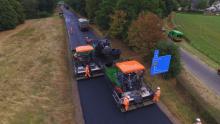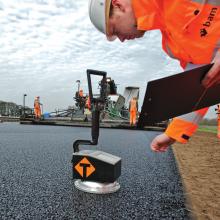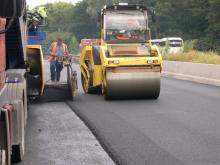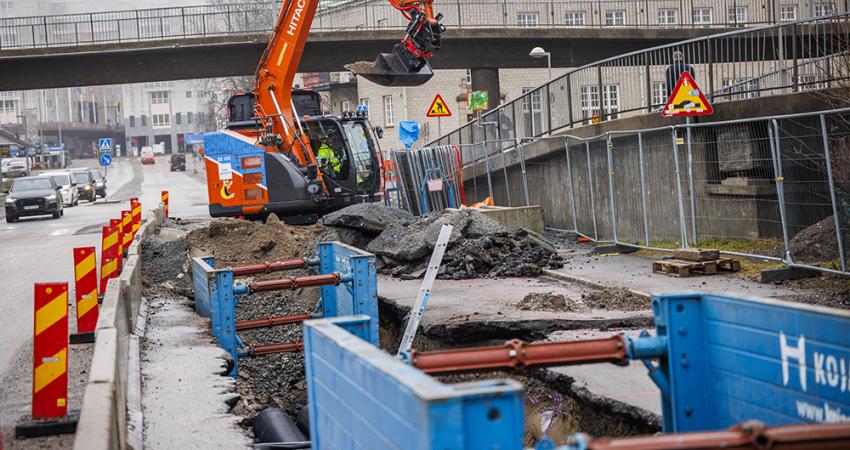An ambitious objective has led to significant steps in the reuse of PA (porous asphalt). While the market incidentally produces PA with a maximum of 30% of recovered raw materials,
‘Maintenance and renovation take up a larger share of road construction activities in the Netherlands than building new roads,’ said Rien Huurman, Research & Development Manager of BAM Infra Asfalt. ‘Our society must not accept the fact that top-quality materials are not being reused! It is this philosophy that led to us to the idea of the 3D road, where guaranteeing improved traffic flow, reducing noise levels, and promoting sustainability are the three conditions that all our innovations are designed to comply with.’
European support
With LE2AP, BAM has changed course for a different way of asphalt recycling. LE2AP stands for Low Emission Asphalt Pavement, with the 2 referring to a double reduction in emissions: noise and the environmental burden. Since this matched BAM's concept of the 3D road, the company applied for a grant from the European Commission. ‘A €1.3 million grant under the LIFE+ programme was awarded in July 2013, which BAM matched by an investment of another €1.3 million in order to enable LE2AP,’ added Huurman's colleague Mark Frunt, head of Consultancy and Development. LIFE+ (now just LIFE) stimulates innovative natural and environmental technologies in Europe.
PA-Stone: a quality product
So far, asphalt has been reused by heating it and mixing it with hot new raw materials. This rather unsophisticated method does not really enable surface layers to be recycled, as a result of which reused surface layers mainly end up in the lower and intermediate layers, and old asphalt is used in road foundations. ‘This means that high-quality materials are lost,’ emphasized Huurman. ‘Our approach is the horizontal reuse of raw materials on the condition that this will enable us to develop surface layers with the same quality, safety value and lifetime as newly produced surface layers. Here, BAM mainly goes for PA that is almost impossible to recycle with existing techniques.’
‘We mill the PA surface layer and process it in our new mobile separation installation to produce separate fractions of raw materials: stones and mortar, the binder in asphalt,’ said their colleague Rémy van den Beemt, head of Technology. ‘This installation is unique in the Netherlands. We separate all stones larger than 2mm from the mortar which has a grain size of less than 2mm. These stones no longer have their mortar skin and they contain little or no bitumen. KIWA has certified this 'PA-Stone' as a fully-fledged building material. Furthermore, we have already used PA-Stone in some road construction projects. Our capacity now is 100,000tonnes a year which makes up 10% of our requirement of new stones. We intend to scale this capacity up in the near future.’
Mortar: a challenge
The quality of mortar, the binder in PA and other types of asphalt, determines the quality of a PA surface layer. Mortar consists of bitumen, filler material and sand but, when separated from the stones, it cannot be reused just like that since it ages in the surface layer. In its own laboratory, BAM has developed a method to restore the reclaimed mortar to the quality level of new mortar. This is done by heating it to approx. 170°C and enriching it with soft bitumen and rejuvenation materials. Actively stirring the hot mortar causes it to homogenise. Tests have demonstrated an even better level of performance than that of the commonly used new mortar. Furthermore, the reclaimed mortar does not get into contact with a flame and air, as would be the case with common asphalt recycling practices, and, as a result, it does not age in the further re-use process. The emission of CO2 is also prevented. The reclaimed stones then need to be heated in order to be able to mix them with reclaimed mortar, according to a specific formula, and produce new asphalt.
BAM set itself the sustainability objective of reducing the commonly applied production temperature and, as a result, CO2 emission. The solution was found in mortar foaming. With the development of its low-temperature asphalt, LEAB, BAM has gained considerable expertise and experience in bitumen foaming. The development team used this expertise as part of LE2AP in order to foam reclaimed mortar, which acts like a yoghurt rather than like an oil at 170°C. Foamed mortar is much easier to mix with reclaimed stone, enabling the production temperature to be lowered. The goal is reducing the commonly applied 160 - 170°C to 80°C. This considerably reduces energy usage and CO2 emissions. The reuse of the bitumen in the mortar also reduces CO2 emissions, since it does away with the requirement of new bitumen, a by-product of the distillation of crude oil.
On track
BAM expects to construct the first kilometre of road with PA, largely made from reused raw materials, in late 2016. The indications are all very positive. ‘We're on track,’ said an enthusiastic Huurman. BAM has now started to build production capacity. Its own asphalt production plants will be gradually converted to the production of LE2AP asphalt mixtures, including dryer-drums for the PA-Stone. Incorporating the new mortar mixture into the production process is also being given a lot of attention.
For now, the recycled mortar can only be heated on a semi-industrial scale. Ernst Demmink, the head of the company's Technical Bureau, is looking into the technical puzzle of the large-scale application of the reclaimed mortar in the mixing process. BAM is focusing on market players that can help solve this puzzle, making PA with 90-95% reused raw materials available in the market. This high percentage, combined with higher quality mortar and less CO2 emission, can definitely be considered a breakthrough in the production of sustainable asphalt.
In October of last year, 60,000kg of sustainable PA, consisting of nearly 95% reclaimed material and produced at slightly over 100°C, were installed at the Brabantse Asfalt Centrale (Brabant Asphalt Plant) in Helmond, the Netherlands. This test was a great success. ‘We produced twice as much PA as planned for that test, simply because it went smoothly. Which was great!,’ said Mr Huurman. Later this year, the one-kilometre long demonstration project will get a double layer PA. The lower layer will consist of reclaimed stones and the reprocessed mortar that will be 90 to 95% recycled material. The thinner top layer will consist of reclaimed stones and possibly fresh mortar with polymer-modified bitumen, with 80-85% recycled material. The combined layers are good for 85-90% of material reuse, and the double layer of PA will also lead to a noise reduction of at least 7dB.
Traffic flow: a focus area
Improving sustainability and reducing traffic noise enables BAM to comply with two of its own objectives for the 3D road. ‘Our ambitious 3D road should also reduce nuisance levels for the surroundings,’ said Mr Huurman. ‘This means reducing traffic hindrance during reconstruction, and less transport. We intend to carry out the entire process of milling, separating and processing PA, and mixing it to asphalt again, on the construction site, as this will further reduce costs, the burden on the environment, and construction traffic. We are convinced that this will be possible with new investments and creative solutions. We see LE2AP as a major step towards our 3D ambition and we definitely plan to take the next steps. We consider this to be part of our social responsibility.’








